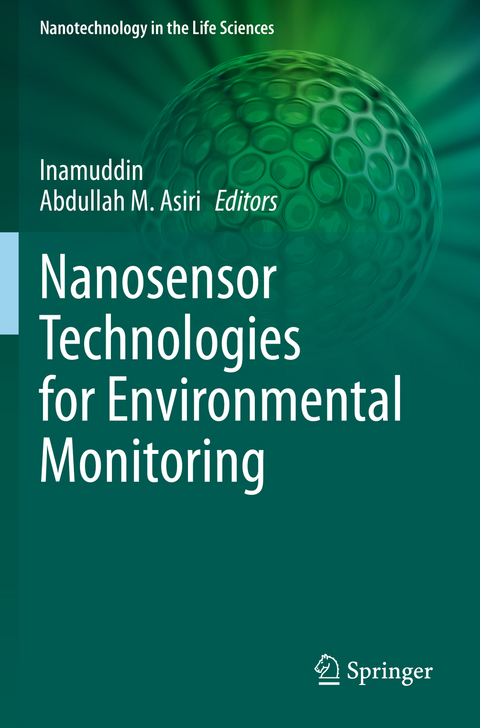
Nanosensor Technologies for Environmental Monitoring
Springer International Publishing (Verlag)
978-3-030-45118-9 (ISBN)
Advanced materials and nanotechnology is a promising, emerging field involving the use of nanoparticles to facilitate the detection of various physical and chemical parameters, including temperature, humidity, pH, metal ion, anion, small organic or inorganic molecules, gases, and biomolecules responsible for environmental issues that can lead to diseases like cancer, diabetes, osteoarthritis, bacterial infections, and brain, retinal, and cardiovascular diseases. By monitoring environmental samples and detecting these environmental issues, advanced nanotechnology in this type of sensory technology is able to improve daily quality of life.
Although these sensors are commercially available for the detection of monovalent cations, anions, gases, volatile organic molecules, heavy metal ions, and toxic metal ions, many existing models require significant power and lack advanced technology for more quality selectivity and sensitivity. There is room in these sensors to optimize their selectivity, reversibility, on/off ratio, response time, and their environmental stability in real-world operating conditions.
This book explores the methods for the development and design of environmentally-friendly, simple, reliable, and cost effective electrochemical nanosensors using powerful nanostructured materials. More specifically, it highlights the use of various electrochemical-based biosensor sensors involved in the detection of monovalent cations, anions, gases, volatile organic molecules, heavy metal ions, and toxic metal ions, with the ultimate goal of seeing these technologies reach market.
lt;p>
Inamuddin, PhD, is an assistant professor in the Chemistry Department, King Abdulaziz University, Jeddah, Saudi Arabia and is also an assistant professor in the Department of Applied Chemistry, Aligarh Muslim University, Aligarh, India. He has extensive research experience in multidisciplinary fields of analytical chemistry, materials chemistry, electrochemistry, renewable energy and environmental science. He has published about 150 research articles in various international scientific journals, 18 book chapters, and 83 edited books with multiple well-known publishers. His current research interests include ion exchange materials, a sensor for heavy metal ions, biofuel cells, supercapacitors and bending actuators.
Abdullah M. Asiri is the Head of the Chemistry Department at King Abdulaziz University and the founder and Director of the Center of Excellence for Advanced Materials Research (CEAMR). He is placed on list of prestigious highly cited (Hi-Ci) researchers' of the year 2018 powered by Web of Science. He serves on the editorial boards of multiple scientific journals and is the Vice President of the Saudi Chemical Society (Western Province Branch). He holds multiple patents, has authored many books, more than one thousand publications in international journals, and multiple book chapters.
Preface.- Recent Advances in Electrochemical Sensor and Biosensors for Environmental Contaminants.- Research Insights on the Development of Biosensors.- Toxic Gas Sensors and Biosensors.- Biosensors Used for Monitoring Environmental Contaminants.- Screen Printed Electrochemical Sensors for Environmental Contaminants.- Sensors and Biosensors for Environmental Contaminants.- Green Synthesis of (Nano)Materials for (Bio)Sensing.- Green Synthesis of Plasmonic Metal Nanoparticles and Their Application of Environmental Contaminants.- Ionic Liquids Modified Sensors and Biosensors for Detection of Environmental Contaminants.- Nano-Biosensors for Detection of Phenolic Compounds.- Noble Metal: Metal Oxide Hybrid Nanoparticles for SERS-Based Sensors.- Molecularly Imprinted Nanosensors for Microbial Contaminants.- Nanomaterials as Toxic Gas Sensors and Biosensors.- Flexible Substrate-Based Sensors in Healthcare and Biosensing Applications.- Lab-On-A-Chip Devises for Water Quality Monitoring.- Advanced Nanostructure-Based Electrochemical Sensors for Pharmaceutical Drug Detection.- Green Sensors for Environmental Contaminants.- Bibliography.- Index.
| Erscheinungsdatum | 17.07.2021 |
|---|---|
| Reihe/Serie | Nanotechnology in the Life Sciences |
| Zusatzinfo | X, 529 p. 141 illus., 91 illus. in color. |
| Verlagsort | Cham |
| Sprache | englisch |
| Maße | 155 x 235 mm |
| Gewicht | 811 g |
| Themenwelt | Naturwissenschaften ► Biologie ► Botanik |
| Schlagworte | Advanced Nanomaterials • biosensors • Electrochemical studies • Environmental Analysis • Toxic Chemicals • toxic gases • toxic metals |
| ISBN-10 | 3-030-45118-6 / 3030451186 |
| ISBN-13 | 978-3-030-45118-9 / 9783030451189 |
| Zustand | Neuware |
| Haben Sie eine Frage zum Produkt? |
aus dem Bereich


